|
SUPER FIGHTER VERSUS SANGO FIGHTER:
CHINESE WAR ENDS IN AMERICA
by Brandon Cobb
a feature of Diskman Presents
www.diskman.com |
|

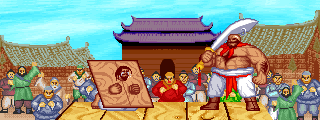 |
Growing up during the fighting game craze of the early 1990s, it was only a
matter of time before I too became swept up in it. At first, my options seemed
limited because I didn't own a home game console and my arcade budget was
limited to the lower-cost games, not the “premium” Street Fighter II that
cost a whopping 50 cents a go. All we had at home was a 386SX-based PC: a
machine which, by most accounts, wasn't powerful enough to tackle an
action-packed game with detailed arcade graphics. Luckily, my fighting game
needs were filled by a totally unexpected source.
On the other side of the world, a Taiwanese company named C&E Inc. had just
released Super Fighter, a game heavily inspired by Street Fighter II. Passed
along dial-up bulletin board systems (BBS), Super Fighter came all the way to
Santee, California, my hometown. I'll never forget it: the huge, detailed
characters; the crisp sound and vocal effects and the beautiful backgrounds.
Everything about the game was fresh and wonderful - not chopped up or
downsampled like the console games my friends were playing. It was an amazing
experience.
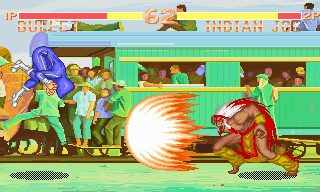
Super Fighter: Bullet versus Indian Joe |
|
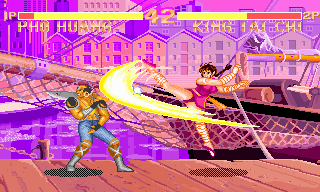
Super Fighter: Pho Huang versus King Tai Chi |
Months later, I discovered yet another gem. Panda Entertainment, also from
Taiwan, had produced a game called San Guo Zhi, introduced to Westerners as
Sango Fighter. The game was unlike any other title in the genre. For one, its
plot revolved around 12 legendary generals drawn from ancient Chinese history,
fighting to unite a nation torn apart by civil war. It was also one of the
first fighting games to include “super attacks,” which could be performed
after filling an energy meter at the bottom of the screen. With more graphics
and character voices than Super Fighter, as well as a few additional features,
Sango Fighter was “the next big thing” for me. I had countless hours of fun.
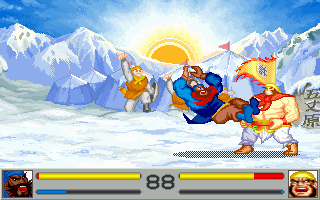
Sango Fighter: Zhang Fei versus Xu Chu
| |
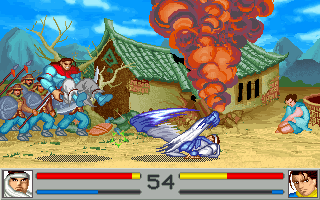
Sango Fighter: Ma Chao versus Zhao Yun
|
That could have been the end of the story, but these two games would do far
more than keep me entertained as a child. Once I had mastered them, my next
quest was to find the people who created them - just to say thanks.
My efforts officially began as a tiny, crudely designed set of webpages,
thrown together when I was 16 years old. The “Unofficial Super Fighter
Website” went live on August 3, 1998, and informed the world about my
favorite fighting game, which had fallen through the cracks in the years since
its release. Fueled by my hope of tracking down C&E, I spread word about
my website to every corner of the internet.
Everyone I encountered, even people in Taiwan, told me I would never succeed,
but I soldiered on. I have never been big on rumor, and no one I spoke with
could prove their claims about the death or existence of C&E. I wouldn't quit
until I reached the finish line, which for me was locating the company's
president and telling him how much I loved his game.
That moment came in 2001, when a former C&E employee decided to search the
internet for his name. He came across my modest Super Fighter website, which
had recently been translated into Chinese by Gilbert Cheung, a friend in
cyberspace and fellow Super Fighter supporter. This former employee, Joseph
Chang, had designed the game's striking characters that had so impressed me.
Finding my website moved him to tears, and in his first e-mail he offered to
help me locate other members of the design team.
Jon Cheng, Super Fighter's lead programmer, was soon introduced to me by
Joseph. Jon was delighted to hear of my interest in his game and had a lot
of interesting things to say about his time at C&E and beyond. He was
gracious in answering all of my questions and wished me luck in tracking down
his former boss.
Several months later I finally found C&E's President John Kuo. Contrary to
popular belief, his company had survived the tough market transition of DOS to
Windows, 2D to 3D graphics, and 16-bit to 32-bit game consoles, a feat which
few Taiwanese companies had managed. Kuo was professional and businesslike,
and his short responses were to the point. Even so, I could sense he was
impressed by my efforts to share Super Fighter with the world, something
solidified when he allowed me to rename my website the “Official Super Fighter Website.”
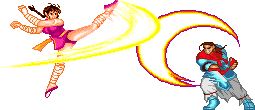
| |
Having axed its entertainment software division, C&E was unable to promote the
game or produce new versions: I was more than happy to take up the task. My
childhood idol handed me the rights to Super Fighter at no cost, and all
because I had taken the time to find him and say thanks. This friendly
encouragement, more or less unheard of in the video game industry, became the
basis of the small company I founded in 2004. Super Fighter Team, named after
the game that had started it all, was formed around the dream that great new
games could be created and released for computers and classic game systems. |
Even with all of the attention Super Fighter was getting, I never forgot about
Sango Fighter. As it turned out, both games were created by some of the same
people — Jon Cheng and Joseph Chang among them — only for two
different companies. This came as no surprise, as both games felt very
similar; both used almost identical data storage methods and had nearly
identical configuration programs.
|
No, the shocker was Sango Fighter's torrid history, which was explained to me
by former Panda employees and confirmed by Kuo. It was a story which, after
reading it, refined and refocused my efforts to support classic gaming.
It started simply enough: after finishing work on Super Fighter, Jon Cheng
decided to leave C&E, mostly for personal reasons. His start with the
then-fledgling Panda Entertainment, as explained to me in his own words, came
about as follows: “A Panda shareholder knew me through a colleague. When he
heard that I had decided to leave C&E, he strongly encouraged me to join
Panda. After discussing the matter with a few other colleagues, we started a
studio and worked by contract for Panda. Our first project was Sango Fighter.
At this time there were only four members in our studio: one programmer, one
character designer and two artists. Four months later, we formally joined
Panda and became shareholders.” |
|
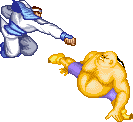 |
Armed with customer feedback about Super Fighter, and recalling his own
personal experiences with the game, Jon became more focused and vowed to
create a superior product. “I didn't have a debugger for Super Fighter, since
I'd used all the system memory to store the game data. The only debugger was
my eyes. I spent nearly four months rewriting the Super Fighter engine with
the help of Soft-ICE, which helped to shorten my debugging time. The resulting
game, Sango Fighter, was released by Panda Entertainment and quickly became
one of the most successful action games on the Taiwanese market.”
This success was short-lived, as the generals would become embroiled in a
legal war. “C&E sued Panda, claiming that some of Sango Fighter's music and
sound playback code was identical to the code used in Super Fighter. Since the
code in question was derived from a book, I wasn't worried about C&E's claim.
However, for some reason Panda decided to accommodate C&E by ceasing all sales
of Sango Fighter within Taiwan. It seems Panda's general manager wished for us
to concentrate on our next game with a clear head, without having to worry
about a lengthy legal battle,” Jon said.
The story got worse from there. While Sango Fighter did indeed make it to
other markets including the USA, Panda Entertainment and its employees never
saw a dime from these foreign sales, something Jon remembers clearly. “It's a
long story, but a company called Accend pirated Sango Fighter and sold it in
the USA. They even used Sango Fighter to cheat Apogee, the largest shareware
company in the USA, out of their 3D game engine. To me, this deception was
heartbreaking,” he said.
And, though official ports of the game did eventually appear for other
machines such as the Japanese PC-98 computer and Taiwan's own Super A'can game
console, they were small accomplishments compared to what could have been. The
A'can was a failure, and the version of Sango Fighter produced for it was a
rushed effort by a different programmer, that was highly inferior to the PC
original. Jon blamed this lackluster conversion on a poor development kit.
“I didn't spend much time with the A'can, but we had one employee who was
dedicated to working with it. Its development kit was very difficult to use,
so it was hard to create A'can games.”
Before C&E's lawsuit, South Korean companies had shown interest in
localizations of Sango Fighter, and one small outfit even developed an
incarnation of it for the Samsung Aladdin Boy, Korea's version of the Sega
Master System. Hearing about the illegal recreation of the game, Cheng was
both surprised and saddened, saying, “Now you see how deeply it hurt Panda to
accommodate C&E. When we released Sango Fighter, we received feedback from
people all over the world, but the legal accommodation killed our sales plans.
We lost many chances to promote this game on the world market.”
Panda had eyed the Sega Mega Drive (aka Genesis) as an ideal platform for the
popular fighting game, but the lawsuit cut these plans short. Panda lost its
chance to be a worldwide cross-console name. Though a vastly improved,
rewritten from the ground up sequel was released for the PC in 1995, by then
it was far too late. “Sometimes, chances don't wait for you. Sango Fighter 2
never got the same attention as the original,” Jon said.
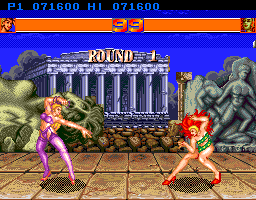
Strip Fighter II: Nina versus Medusa |
|
While Super Fighter had similar shortcomings, such as its official USA release
being cancelled after widespread piracy of the Chinese original, an English
version was released in Australia. The game was also exported to South Korea.
Furthermore, C&E was able to market the game engine to other companies. One
example of this was the smut-peddling Japanese outfit Hacker International's
Strip Fighter II, released in Japan for NEC's PC Engine (aka TurboGrafx-16).
Some of C&E's source code referenced the Hacker partnership, which I later
confirmed in an e-mail exchange with Mr. Kuo.
Though I understood C&E's legal action was a sound business decision made
in the name of protecting its intellectual property and market share, I couldn't
feel too bad for the company on a personal level seeing as how Panda Entertainment
practically had its golden goose snatched from its arms. I was even more
inspired to obtain the rights to Sango Fighter next and give it a second
chance to be presented to and enjoyed by people all over the world. That task
would be plagued with difficulties and would take five years to accomplish. |
When Panda Entertainment went out of business, its intellectual properties
were sold to another Taiwanese company. Trouble was, no one from Panda could
remember that company's name or anything about it! The search seemed hopeless
until Jeff Huang, Panda's former general manager, sent me an e-mail regarding
the situation. “The company was called Art 9 Entertainment. Its general
manager arranged the deal with me, but I don't remember his name. Since I'm
now on the Chinese mainland most of the time, I'm unable to locate the related
documents or information,” he said. I was excited: the company name was a
starting point, and as long as I had that I was confident I could track down
the owner.
After some digging I found a man in Taiwan named Owen, who listed Art 9
Entertainment on his résumé. I contacted him, introduced myself and my intent,
and proceeded to ask him if he remembered the name of his former boss at
Art 9. “Sure. His name is Andrew Li,” he said. Running the name past
Mr. Huang, I got a confirmation: Mr. Li was indeed the one I needed to talk to.
However, finding Mr. Li was another challenge altogether. At the time he was
working for a large education company in China whose offices spanned a range
of the country. No one knew for sure which office he worked at, and the trail
ran cold. While several people helping me with the search shrugged and gave
up, one of our programmers at Super Fighter Team kept trying. Finally, one
night, he presented me with the personal cell phone number of Mr. Li. Success
at last!
Mr. Li, though busy, was cordial over the phone. He was surprised at my interest
to acquire the rights to Panda's games, stating he had left the video game
business years ago. Even so, he still owned the rights to the games, and after
some negotiation we reached a purchase agreement. As a result, in 2009 I became
the official, legal owner of Panda Entertainment's back catalog, including
Sango Fighter and its sequel. Mr. Li contacted Jon Cheng, giving his blessing
for the game source codes to be released to me. I informed Joseph Chang, who
said, “Amazing! You did a wonderful job.”
I was beside myself with joy. My favorite games were finally united under the
same company banner, opening up huge potential for both. Not in my wildest
dreams could I have ever expected to accomplish such a feat.
In 2012, I took things a step further by flying to Taiwan to finally meet my
game industry heroes in person. In the capital city of Taipei, I was warmly
welcomed by John Kuo, Jon Cheng and Joseph Chang. Each of them were friendly
and fun, and we enjoyed our time together. Most importantly, we were no longer
just colleagues or internet buddies: we had become friends in real life.
We've kept in touch since, as we can, wishing each other well in our
professional and personal endeavors.
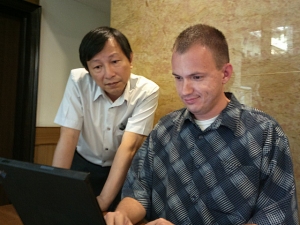
John Kuo and Brandon Cobb |
|
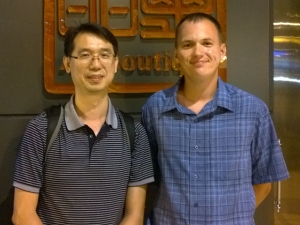
Jon Cheng and Brandon Cobb |
|
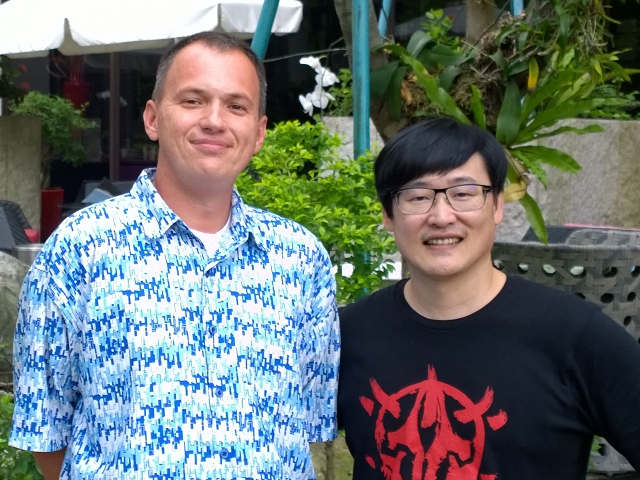
Brandon Cobb and Joseph Chang |
In the years since, my work at Super Fighter Team has taken me across the
world where I have forged more professional partnerships and made more
international friends, learning a great deal about other cultures and myself
along the way. What started as an obsession with a video game became so much
more.
Two Taiwanese fighting games, each with its own remarkable story, may not have
changed the world when they were released, but they certainly changed my life.
The fighting game craze may have perished in favor of other gaming fads, but
it has never left my heart.
|
|
|
|
|
Want to try out the games for yourself?
Super Fighter, Sango Fighter, and
Sango Fighter 2 are all available as free downloads.
Please note: These games — except for Super Fighter Special Edition & Sango Fighter Special Edition —
were developed for MS-DOS. You will need to use DOSBox
to play them under Windows, Mac OS or Linux.
|
| |
|
|
|
“Super Fighter versus Sango Fighter: Chinese war ends in America” article and website content © Brandon Cobb.
|
| |